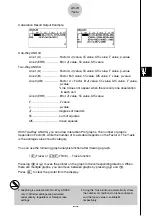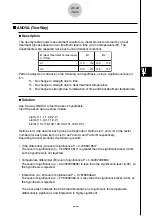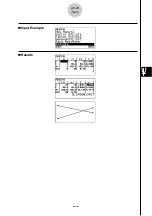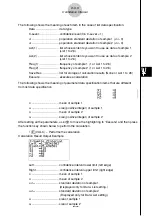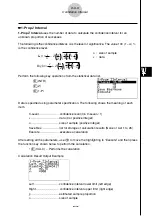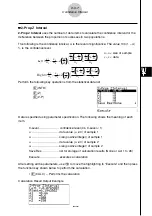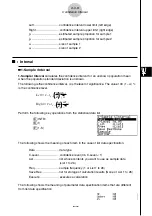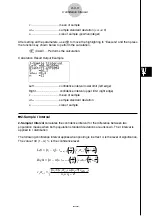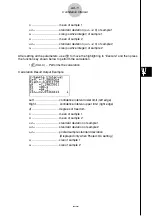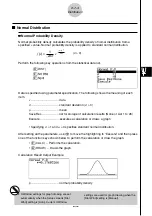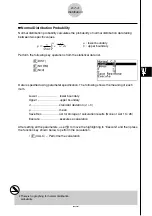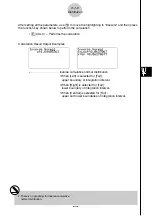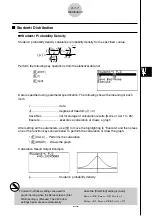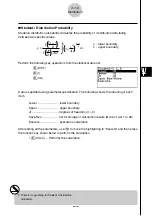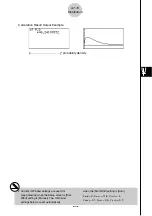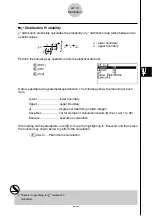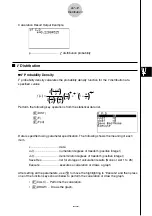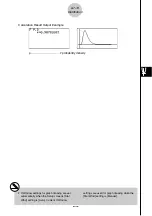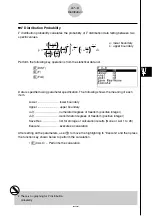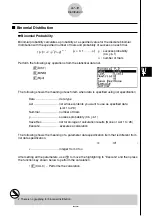
20050401
6-7 Distribution
There is a variety of different types of distribution, but the most well-known is “normal
distribution,” which is essential for performing statistical calculations. Normal distribution is a
symmetrical distribution centered on the greatest occurrences of mean data (highest
frequency), with the frequency decreasing as you move away from the center. Poisson
distribution, geometric distribution, and various other distribution shapes are also used,
depending on the data type.
Certain trends can be determined once the distribution shape is determined. You can
calculate the probability of data taken from a distribution being less than a specific value.
For example, distribution can be used to calculate the yield rate when manufacturing some
product. Once a value is established as the criteria, you can calculate normal probability
when estimating what percent of the products meet the criteria. Conversely, a success rate
target (80% for example) is set up as the hypothesis, and normal distribution is used to
estimate the proportion of the products will reach this value.
Normal probability density
calculates the probability density of normal distribution from a
specified
x
value.
Normal distribution probability
calculates the probability of normal distribution data falling
between two specific values.
Inverse cumulative normal distribution
calculates a value that represents the location
within a normal distribution for a specific cumulative probability.
Student-
t
probability density
calculates
t
probability density from a specified
x
value.
Student-
t
distribution probability
calculates the probability of
t
distribution data falling
between two specific values.
Like
t
distribution, distribution probability can also be calculated for
χ
2
,
F
,
Binomial
,
Poisson
,
and
Geometric
distributions.
On the initial
STAT
mode screen, press
5
(DIST) to display the distribution menu, which
contains the following items.
•
5
(DIST)
1
(NORM) ... Normal distribution (page 6-7-3)
2
(t) ... Student-
t
distribution (page 6-7-7)
3
(CHI) ...
χ
2
distribution (page 6-7-9)
4
(F) ...
F
distribution (page 6-7-12)
5
(BINM) ... Binomial distribution (page 6-7-16)
6
(
g
)
1
(POISN) ... Poisson distribution (page 6-7-19)
6
(
g
)
2
(GEO) ... Geometric distribution (page 6-7-21)
6-7-1
Distribution
Summary of Contents for fx-9860G AU PLUS
Page 1: ...fx 9860G AU User s Guide E http edu casio com ...
Page 2: ...Important Please keep your manual and all information handy for future reference ...
Page 27: ...20050401 1 1 Keys 1 1 1 Keys ...
Page 335: ...20050401 u u u u u Input Example u u u u u Results 6 5 25 Tests ...
Page 361: ...20050401 Calculation Result Output Example p F distribution probability 6 7 15 Distribution ...
Page 435: ...20050401 8 8 2 Program Library egcw w ww w ...
Page 437: ...20050401 8 8 4 Program Library Example 1 Example 2 fw baw bf w fw baw ca w ...
Page 439: ...20050401 8 8 6 Program Library wba wb w w d ...
Page 441: ...20050401 8 8 8 Program Library dw fcde wfcde wfcde fcde w daw w 20070101 ...
Page 443: ...20050401 8 8 10 Program Library b awaw bwaw aw x d w ...
Page 590: ...CASIO COMPUTER CO LTD 6 2 Hon machi 1 chome Shibuya ku Tokyo 151 8543 Japan SA0701 E ...

